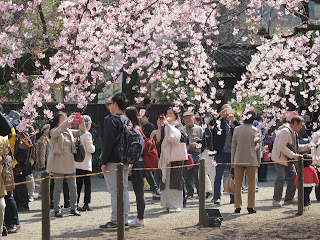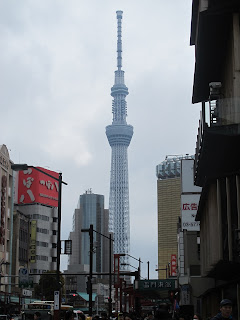After leaving Izumo we went on a modern overnight train. Our rooms looked like pod hotel, it had a large window, a one person bed, and virtually no floorspace. I didn’t do much more than look out the window and take photos.
After getting off of the train in Tokyo we were picked up by Camille’s friend Shigeru, Shigeru was an exchange student at Putney while Camille was there. He showed us to the JVC Victor recording studio (one of the biggest in Tokyo) where he has worked for the last 20 years. Camille and I marveled at the studio, Camille at the rooms and sound quality, and I marveled at all the buttons and switches. Shigeru has a daughter named Natsuki, a son named Yosuke, his wife is called Emi, and their affectionate and annoying toy poodle is called Ado. Their house is modern and minimalist. At one point Natsuki brought and made a packet of candy sushi mix which we filmed and posted.
Speaking of food, I was surprised to see a Mexican restaurant right next to a sushi bar. One interesting place we ate was a health food restaurant where you choose a type of rice and 3 small side dished as well as a bowl of soup, and amazingly, it was just enough. On our last night they cooked dinner for us. They made a delicious dish of little dough dumplings stuffed with octopus bits. They made it with an object somewhat like a waffle iron.
On our second day they took us to the Rikugien ‘garden’ (really a small park) which seemed to be mainly visited by young children and old women and men. We unintentionally arrived in Japan right in the beginning of cherry blossom season, or sakura in Japanese, so there were tons of domestic tourists taking selfies with the pink blooming cherry trees. The garden looked like the one in Okayama, but smaller and with more trees. Something we saw that was new to us were foot bridges with grass growing along the sides.
On our fourth day we visited a very famous temple called Sensoji, in a neighborhood called Asakusa. In front of the temple was a large market dedicated to everything from traditional Japanese pastries to cheap plastic toys. People weren’t allowed to eat in the main passage because that would slow the extremely slow traffic of tourists, pilgrims, and shoppers. The temple itself was not as grand as some of the others we had seen, but it was grand. The temple was divided in two parts: the part for visitors, and the part for worshippers. Both parts were open to the public, but the area for worshippers was restricted only for worship, so no photos or non religious tourists. When we visited, the monks were playing some really intense music that I could only relate to battle music. It was layered with loud drums and gongs.
After that we went to a neighborhood that was filled with manga and anime shops. Anime is short for animation, but now refers specifically to Japanese animation. Manga is a kind of anime in which characters have large exaggerated features, especially eyes. The shops had a much wider variety of shoppers than I would have imagined, both in terms of gender and age, even in the adult manga bookstore (18 and over only) where I had to wait outside while Camille bought magazines for Oscar. The second floor had a figurine and plushie store with some collectible anime figurines obviously made for adults (big breast, butts, and others that were clearly fetishes), and toys which we would normally associate with kids (i.e. Dragon Ball Z, Pokemon etc.), all mixed together. The building next door had a huge arcade with digital Pokemon booths. I played a few times and got pretty good (I think).
The next day we went to one of the most anticipated things about out trip to Japan, the Ghibli Museum, dedicated to the work of Miyazaki and the Ghibli studio (some of their movies include Nausica in the Valley of the Wind, and My Neighbor Totoro). It was really hard to get tickets, and we are lucky to even have gone at all. When we arrived we were greeted by a life sized Totoro in the ticket booth. After sitting in line for what seemed like forever, we got to the front desk. The building itself was stuffed with little secrets and easter eggs (hidden references) only a true Ghibli fan would notice. The museum was small and cozy. The first exhibit we saw was a simple introduction to animation, but more particularly circular animation. Circular animation is the process in which one spins some object containing a circular arrangement of movement stages and imposes a strobe light to eliminate the sense that it is spinning, for example: a disk with a circle of people walking around the edge, or even several glass tubes revolving around each other. The examples they provided were an animation of a Totoro jumping up and down, a large figurine of a tree overlooking many characters doing many things, and a Castle in the Sky guardian robot holding his arms open to the birds flying around him. We also saw an interesting frame (not circular) animation about a character going through all the stages of evolution due to being constantly chased by varying creatures. Also on the first floor there was a small movie theater where we saw a short film about a water spider who falls in love with a water-bug. The second floor had an exhibit meant to look like Miyazaki's office. The walls were covered in swift character sketches. There were books on botany, biology, gardening, and architecture. There was a JUG full of the stumps of colored pencils. And there was an installation on how they animated the characters over the backdrop with clear film. There was also a cat bus where kids could play, a temporary exhibit on the aeronautic travel of Miyazake, and on the roof was a large guardian statue and a stone from Laputa in the castle in the sky.


















































